How to Master Content Management From Start to Finish
 Content management often gets overlooked by marketing teams, and it’s understandable; there is simply not enough time or resources to dedicate to building a consistent process, and the longer it goes unchecked, the greater the issue becomes.
Feel like your assets keep piling up? Unable to find pieces of content you published last year? Losing track of important steps in the production process? If you answered yes to any of these, you need a content management process.
In this post we’ll clarify some misconceptions about content management so you know exactly what it is and why you need to do it. We will also provide the steps and resources so you can get started building your own content management process that your whole team can use to plan, create, and organize every individual asset.
There’s no better time to dig yourself out of that pile of mismanaged and hard to find content assets than right now, so let’s get started.
Content management often gets overlooked by marketing teams, and it’s understandable; there is simply not enough time or resources to dedicate to building a consistent process, and the longer it goes unchecked, the greater the issue becomes.
Feel like your assets keep piling up? Unable to find pieces of content you published last year? Losing track of important steps in the production process? If you answered yes to any of these, you need a content management process.
In this post we’ll clarify some misconceptions about content management so you know exactly what it is and why you need to do it. We will also provide the steps and resources so you can get started building your own content management process that your whole team can use to plan, create, and organize every individual asset.
There’s no better time to dig yourself out of that pile of mismanaged and hard to find content assets than right now, so let’s get started.
How to master content management from start to finish.
Click To TweetMake Content Management Easy With These Templates
Before we get into the good stuff, go ahead and download your free content management bundle. It includes templates for everything we’re about to discuss — including editorial workflows, content audits, and folder structures.- What Exactly Do We Mean By Content Management?
- What Tools Do You Need for Content Management?
- What Does the Right Tech Stack for Content Management Empower Teams to Do?
- How to Develop a Content Management Process
- 1. Determine What Types of Content to Manage
- 2. Assemble Your Content Management Toolstack
- 3. Set Clear File Folder Structures
- 4. Establish Clear File-Naming Conventions
- 5. Create a Clear Tagging Structure
- 6. Set Guidelines for Structuring Other Relevant Metadata
- 7. Establish Guidelines for Version Control
- 8. Build Workflows for the Creation of Content
- 9. Set Clear Governance Guidelines
- 10. Create a Process for Auditing Content
- 11. Educate Your Team Members
What Exactly Do We Mean By Content Management?
Are you wondering what “content management” actually means? A quick scan of the term in Google shows lots of different things. You might see content management being mentioned as two different things: Granted, the two are intertwined; you may need to use a CMS, like WordPress, to produce content. We, however, will be focused on the content management practice side, or the tasks you and your team need to put a piece of content into the world.
As such, we will be using this working definition: A content management strategy details how you create, develop, organize, and govern the content you’re creating. That’s what we’ll focus on throughout this guide.
Granted, the two are intertwined; you may need to use a CMS, like WordPress, to produce content. We, however, will be focused on the content management practice side, or the tasks you and your team need to put a piece of content into the world.
As such, we will be using this working definition: A content management strategy details how you create, develop, organize, and govern the content you’re creating. That’s what we’ll focus on throughout this guide.
What Tools Do You Need for Content Management?
We already know that you’ll need a CMS to help you manage content, but what other tools do you really need? Here are three that work together to provide your team with everything you’ll need for content management.CMS Software
A Content Management System houses the content you’re creating in the backend of your business. It’s a tool that allows multiple people to create, edit, and publish content. Usually, it’s the platform you’re using to run your eCommerce site, such as:Content Management Platforms (CMS Platforms)
You might also use a content management platform alongside your CMS. There are plenty of options, especially when it comes to WordPress. WordPress has 65.1% market share in the CMS market, and over 55,000 plugins available on their directory — including several content management tools. You should choose a content management application that integrates with your CMS to manage website and digital marketing content, such as: Note: you may also see these called an “enterprise content management (ECM) system.” They do the same job, but are just marketed towards bigger companies. You can also store emails inside one.You can also store emails inside an enterprise content management system.
Click To TweetDigital Asset Management Software
Chances are, each piece of digital content you’re producing has multiple assets. Think of a blog post, for example. You might have an outline, first draft, and five graphics to go alongside the content. A digital asset management software, such as those listed below, helps keep track of each individual piece of content. You know exactly where each file is:
What Does the Right Tech Stack for Content Management Empower Teams to Do?
Well, there are lots of things, but we’ll just name a few.Publish and Update Content Without Needing IT
If there’s one thing that’ll slow your content production down, it’s waiting for approval. Granted, you might need approval from editors at key stages throughout the content lifecycle. With the right content management tech stack in place, you can cut out the need to wait for approval from your IT team. You’ll be able to upload content, embed videos, and store things in a place that’s easy to find. The end result? Content creators and content managers can get their job done as quickly as possible — leaving extra time to start producing another piece.Effectively Organize All Types of Content
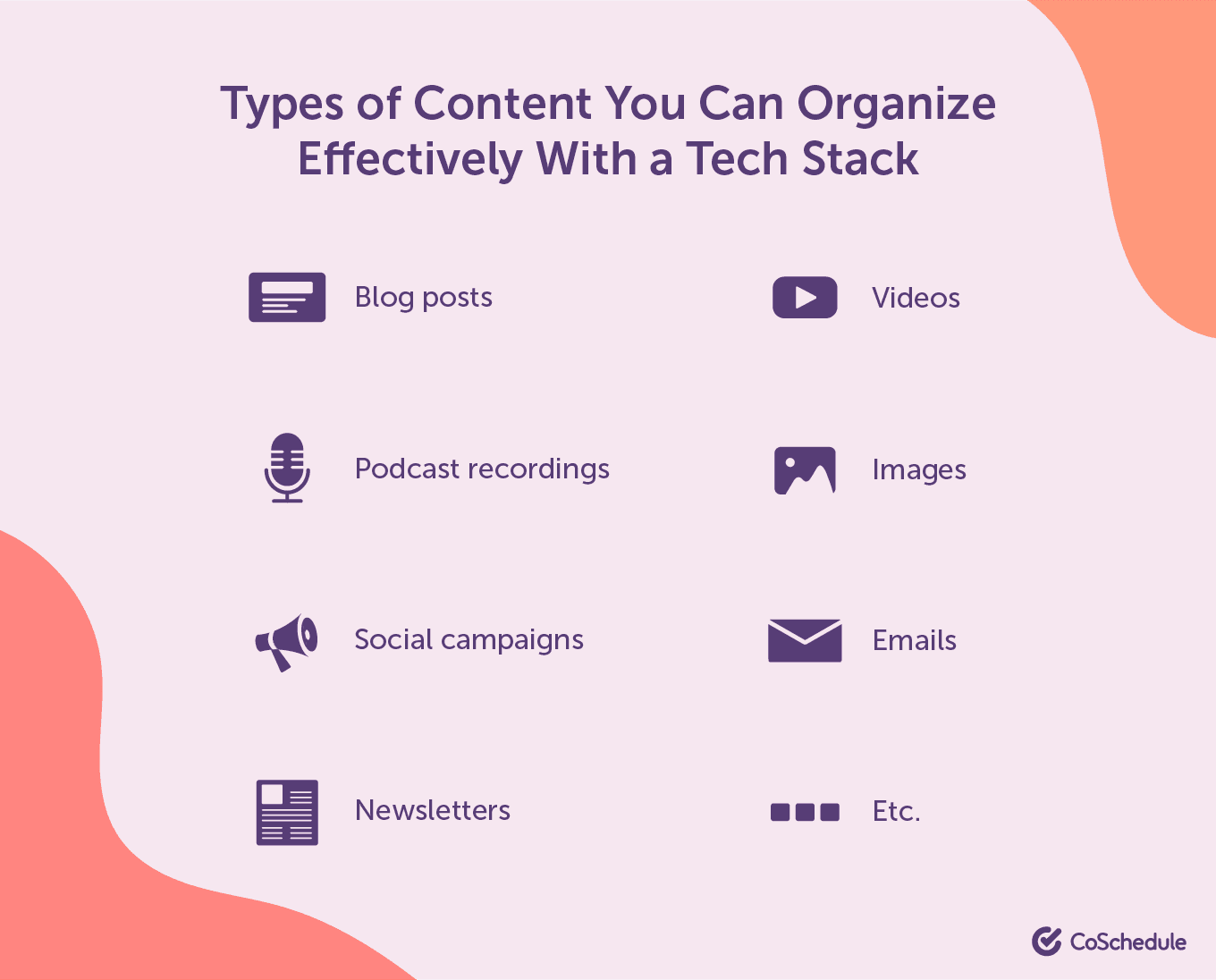 A robust tech stack to manage your content means you can organize each type of content you’re creating. No more “Where did I put that infographic I worked on last week?” needed.
A robust tech stack to manage your content means you can organize each type of content you’re creating. No more “Where did I put that infographic I worked on last week?” needed.
Track Changes to Content and Manage Version Control
The content creation process isn’t as simple as “create and publish”. Chances are, you have editors on your team who need to proofread the content. You might also have several people working on a piece of content simultaneously. Having a content management process means your team doesn't get confused. They’ll know which version they should be working on — regardless of how many files you have.Easily Accessible Content
How many times have you had someone ask where they can find something? It’s just not sensible to spend your time digging through documents and files. It’s a huge timesuck. A defined content management process explains how people should find content inside your asset management software. That way, any piece of content is easily accessible to anyone who needs it.How to Develop a Content Management Process
Sold on the value of having a written process that helps your team manage content? Not only does it help you move faster, but it's a competitive advantage — just 42% of marketers have a documented strategy for managing their content as a business asset. Some 63% of them say it’s because of a lack of process.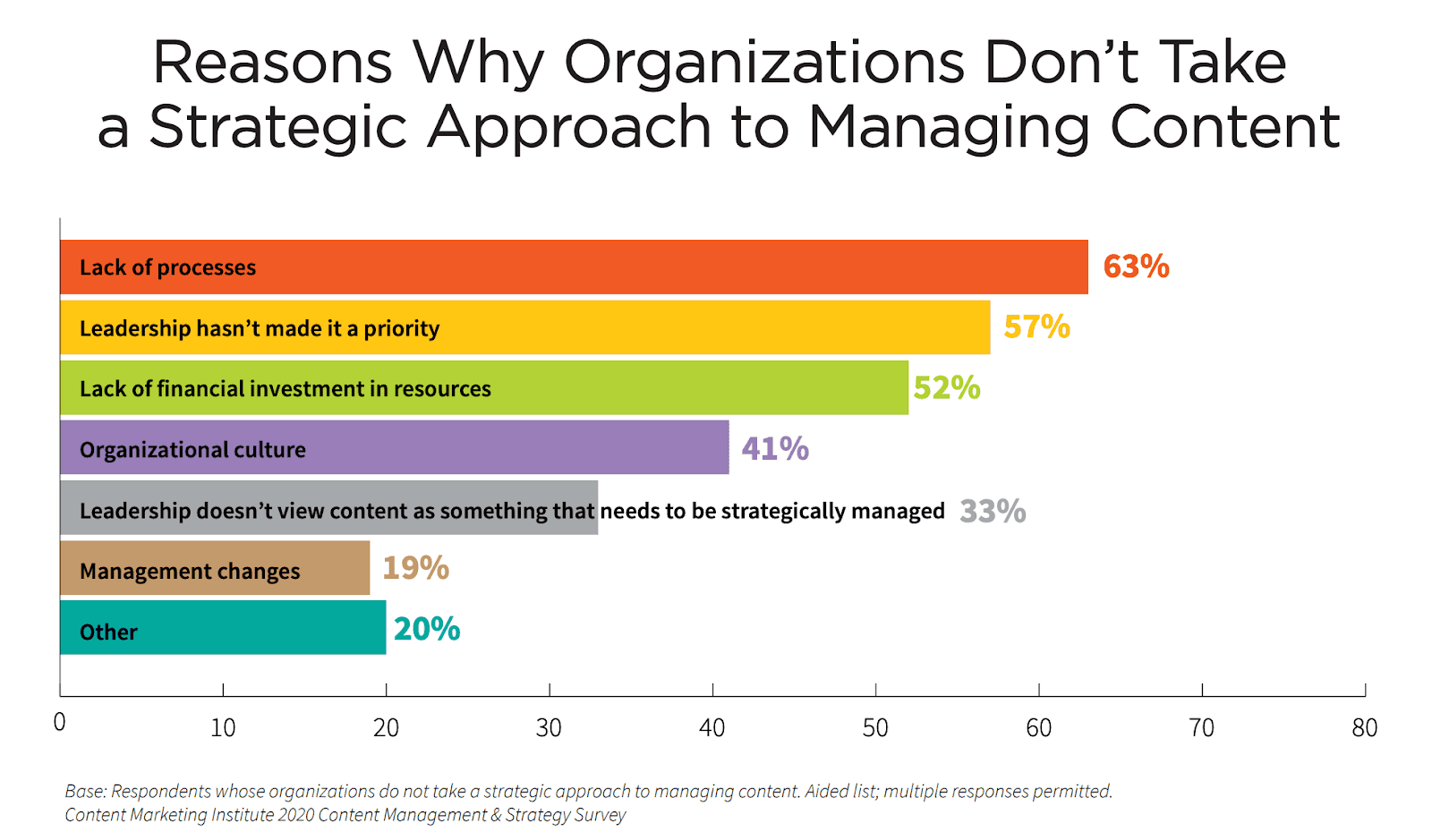 We’re here to solve that problem. Here’s a step-by-step guide you can use to develop a content management process for every type of content you’re creating, from start to finish.
We’re here to solve that problem. Here’s a step-by-step guide you can use to develop a content management process for every type of content you’re creating, from start to finish.
1. Determine What Types of Content to Manage
Before we dive into any of the advanced content management steps, take some time to think about the types of content you’re producing. This will have a domino effect on the software you’ll need. Let’s put that into practice and say you’re producing this multimedia content:- Videos
- Audio podcast recordings
- Graphics
- Email copy
- Text-based blog posts
2. Assemble Your Content Management Toolstack
Speaking of the software you’d need, now’s the time to put together your toolstack. As a quick reminder, here are the three things in which you’ll need to invest:- CMS software (e.g. WordPress)
- A content management platform (e.g. Kapost)
- Digital asset management software (e.g. CoSchedule)
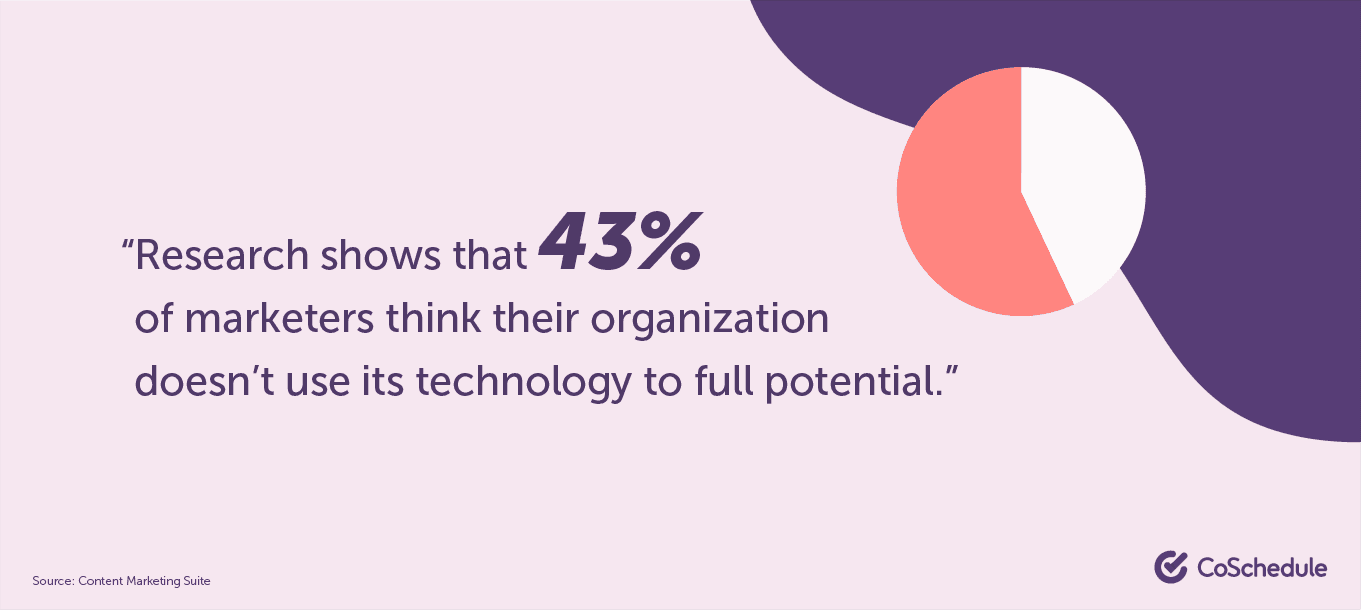 Source: Content Marketing Suite
During this stage, think about the other teams who might need to use them.
Your content marketing department isn’t the only team who’ll need to use these platforms. Other departments create content, too — even if it’s not content you’re pushing into the public.
Your sales team might need to find content to answer a lead’s question; the people on your branding team will want to create a brand messaging framework for every new starter to read through.
Bring up the conversation of each tool to the heads of each department. Figure out how they’re already managing content and the issues they have with it.
For example, you might find your blogging team has issues with managing blog posts submitted by external writers. If you can position each tool as an investment to help the entire company — as opposed to just your marketing team — it’ll be easier to get buy-in.
Source: Content Marketing Suite
During this stage, think about the other teams who might need to use them.
Your content marketing department isn’t the only team who’ll need to use these platforms. Other departments create content, too — even if it’s not content you’re pushing into the public.
Your sales team might need to find content to answer a lead’s question; the people on your branding team will want to create a brand messaging framework for every new starter to read through.
Bring up the conversation of each tool to the heads of each department. Figure out how they’re already managing content and the issues they have with it.
For example, you might find your blogging team has issues with managing blog posts submitted by external writers. If you can position each tool as an investment to help the entire company — as opposed to just your marketing team — it’ll be easier to get buy-in.
All departments of your business are creating content, so they'll need help with content management.
Click To Tweet3. Set Clear File Folder Structures
Once you’ve got a robust toolstack in place for content management, it’s time to set some ground rules. How often do you passive-aggressively dig through several folders in your computer, trying to find a file your co-worker has saved somewhere? It happens all too often — and in the worst case, could cause content to go missing. That’s why you’ll want to set clear file and folder structures inside your asset management tool. They’re guidelines for:- Which folders you’ll have.
- When to create a new folder versus using an existing one.
- What folders should be created inside other folders.
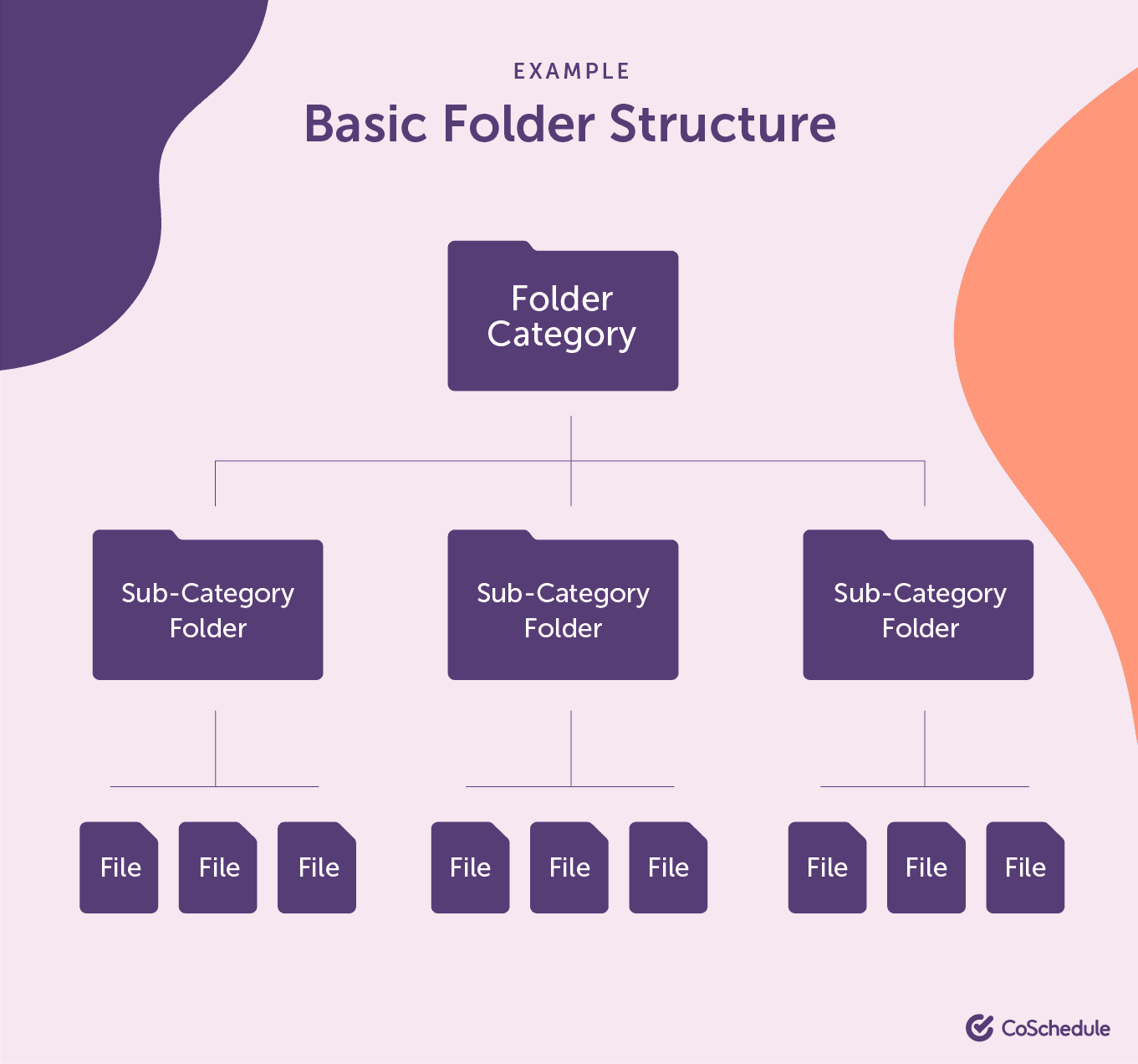 Here’s what that might look like in practice:
Here’s what that might look like in practice:
- Folder: Blog posts
- Folder: 2021
- Folder: How to Write a Blog Post
- File: blog post draft
- File: editor’s feedback
- File: supporting image
- Folder: How to Write a Blog Post
- Folder: 2021
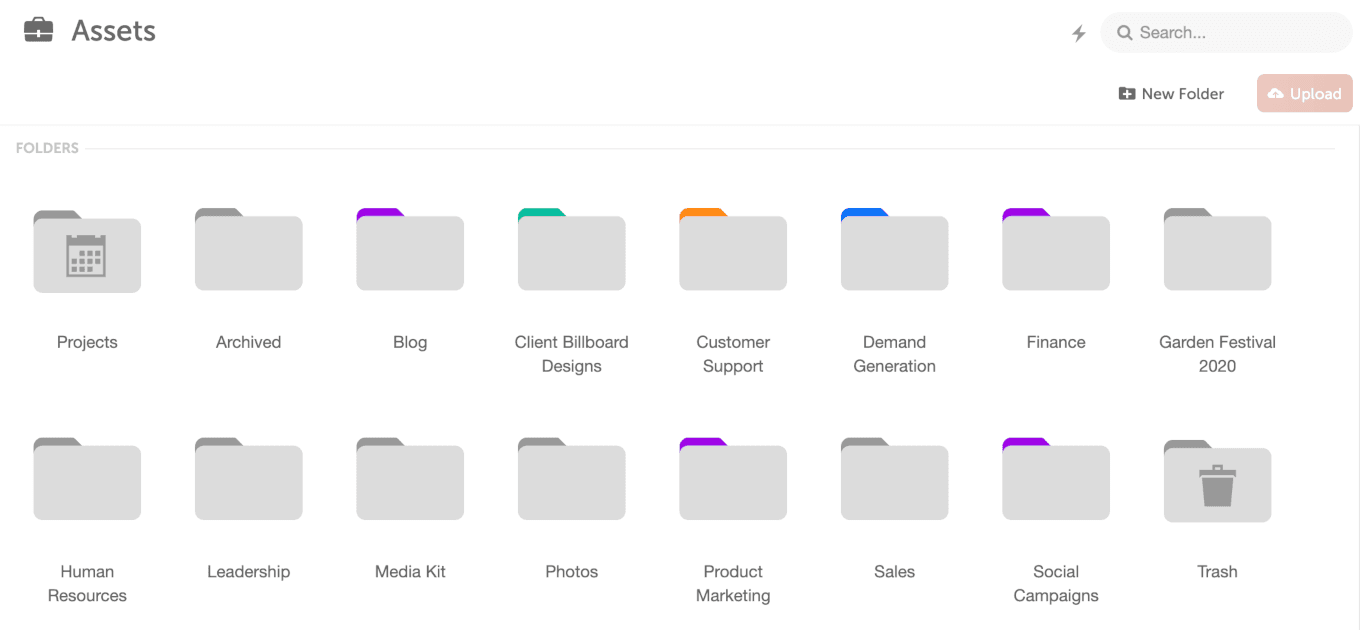
4. Establish Clear File-Naming Conventions
Once we’ve got the folder structure in place, start to think about the names you’ll give to each file. Let’s face it: we’ve all been in the situation where you’re trying to find the latest version of a blog post, only to see three individual files, each with “FINAL” on the end. But there's a better way. We can call this a file naming convention: it’s basically the rule you’re creating for how everyone on your content team should store their files. Everyone will then use the same format when they’re saving a piece of content inside your asset management software. File naming conventions help you easily search for something, too. With consistent naming across everything in your asset management system, you can type the exact file name without having to guess 10 different combinations. What do those formatting rules look like? Here are some examples:- What your spaces look like (such as “final-blog-post” or “FinalBlogPost”).
- Whether to include the type of content in the file name (such as “image-blogging-statistics”).
- How to name the final version of something (such as adding “draft” to unapproved documents and renaming it to “final” when it’s been signed off).
- If you’re including dates or departments in the file name (such as a folder named “2021-blogging-team”).
You can only find the asset you’re looking for if the name formats are consistent!
Click To Tweet5. Create a Clear Tagging Structure
Want to make content management even easier? When saving files, create a tagging system. It goes a step above proper naming and means you can see all of the documents in your entire library under that specific tag. That means you can:- See all files tagged “blog posts” when doing a content audit.
- Browse files tagged “email” to see the folders created by your email team.
- See files tagged as “needs reviewing” and approve them all in one go.
- Filter for the tag “non-profit” to see which assets you’ve made for a nonprofit you support.
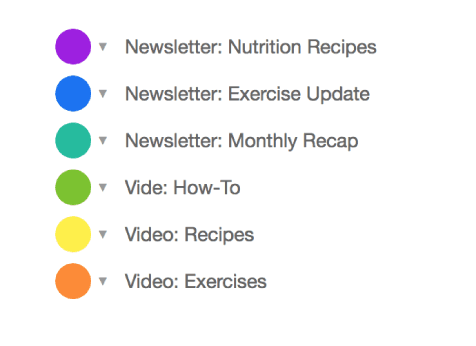 Just remember that, just like the other naming conventions we’ve mentioned so far, your tags must be consistent. It’s not effective if everyone on your team forgets to tag files or folders.
Just remember that, just like the other naming conventions we’ve mentioned so far, your tags must be consistent. It’s not effective if everyone on your team forgets to tag files or folders.
6. Set Guidelines for Structuring Other Relevant Metadata
Speaking of consistency, you’ll have other snippets of data inside your content library that need to follow the same structure. Keeping this metadata consistent across your entire team makes things easier to find. That way, when you’re managing large volumes of content submitted by different people, they know which conventions to follow.
Keeping this metadata consistent across your entire team makes things easier to find. That way, when you’re managing large volumes of content submitted by different people, they know which conventions to follow.
7. Establish Guidelines for Version Control
Content is a collaborative process. You likely have different people working on the files inside your CMS or asset management system — including writers, editors, videographers, and social media managers. If you’re adding “FINAL” to the end of an asset each time someone has updated it, you might be left with four “final” blog posts. How do you know which is the real final file; the one you can publish? The answer lies within version control rules. It tells everyone creating content how they should show the status of a particular asset. Again, there is no rule for the formatting you should use. That might be:- Adding “V + the version number” to the end of each file (e.g. “video-v3”).
- The stage in the content creation process (e.g. “podcast-raw-recording”).
- Labelling the file name to the person who last edited it (e.g. “video-john-edits”).
8. Build Workflows for the Creation of Content
Are you flying by the seat of your pants when creating a new piece of content? Perhaps you sometimes create a custom thumbnail for each video or send a HARO query for a blog post — only if you remember. A workflow stops you from doing things only if you remember to do it. It’s a list of steps you’ll take when creating each type of content, which makes sure each piece is consistent — regardless of which team member created it. Here’s what a workflow might look like for video production. It lists the individual subtasks needed to create the final piece of content, shows who will take responsibility for it, and when it’s due.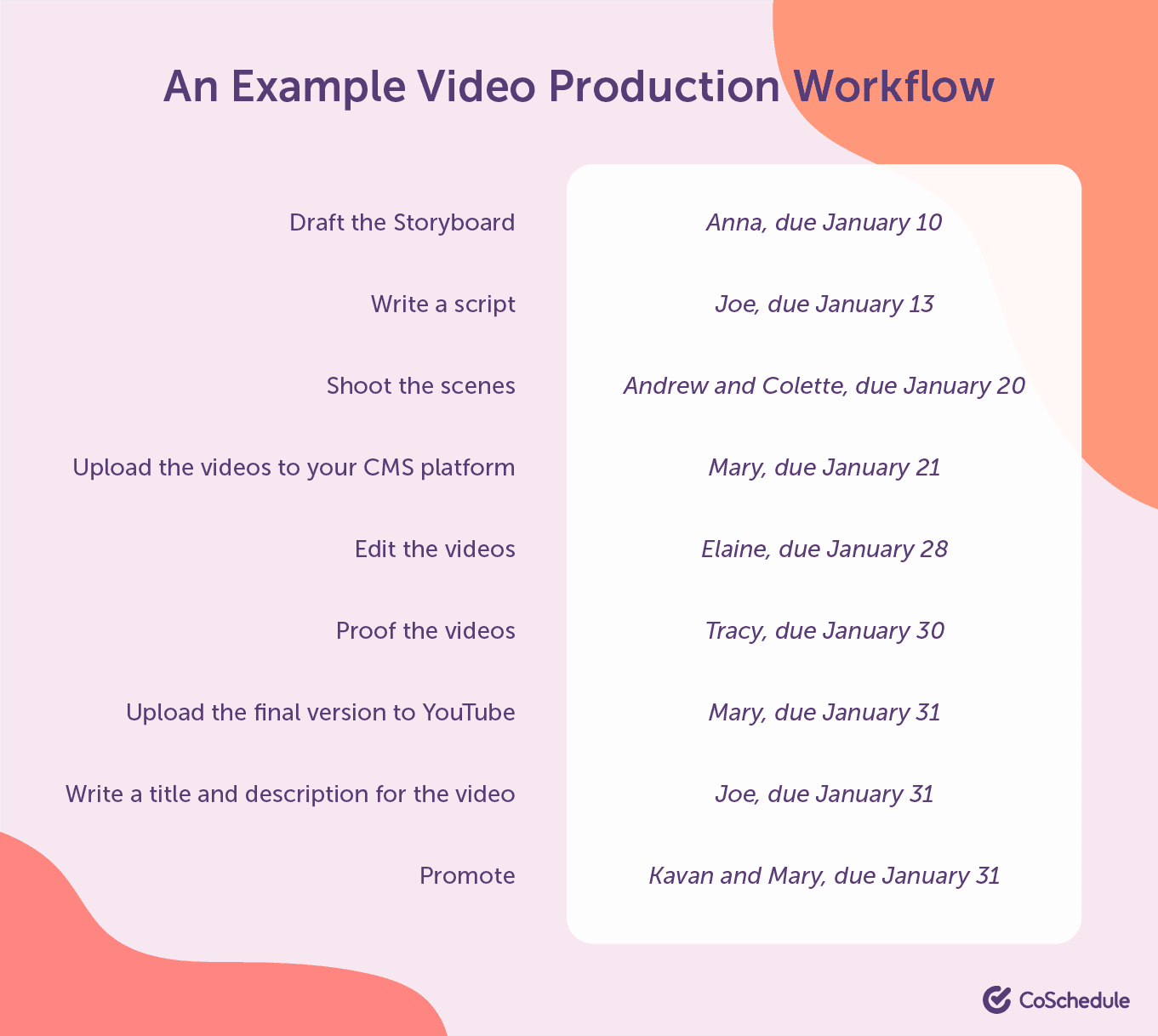 The overall task is labelled “in progress” when some tasks are waiting to be checked off.
A good content management platform makes this step easier than it looks. In CoSchedule, for example, you can create workflows for each piece of content and save them as a Task Template.
You’ll only have to create each workflow once. Simply duplicate the template whenever you’re creating a new piece of content.
The overall task is labelled “in progress” when some tasks are waiting to be checked off.
A good content management platform makes this step easier than it looks. In CoSchedule, for example, you can create workflows for each piece of content and save them as a Task Template.
You’ll only have to create each workflow once. Simply duplicate the template whenever you’re creating a new piece of content.
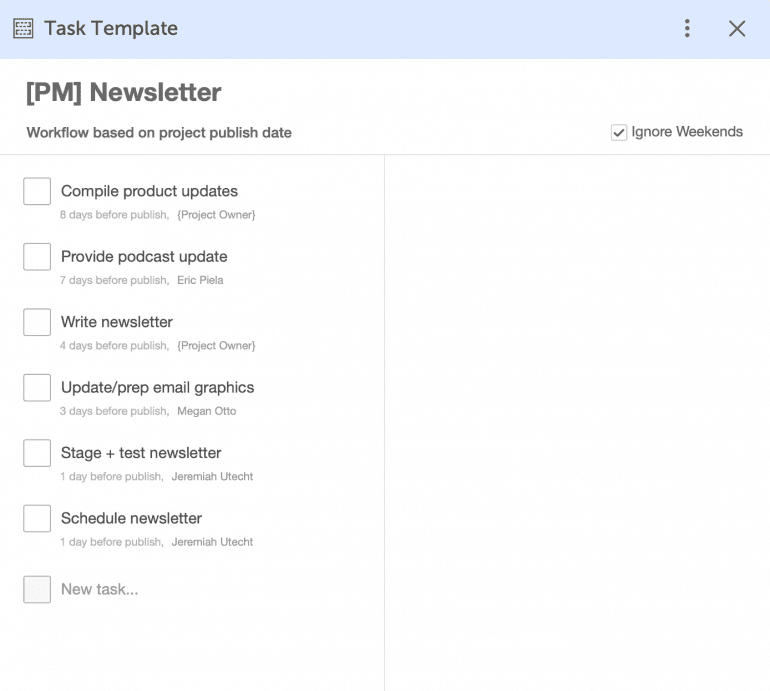 The truth is: your success with content management all boils down to great organization — something we found makes marketers 397% more likely to report success. Clear content workflows make that a walk in the park.
The truth is: your success with content management all boils down to great organization — something we found makes marketers 397% more likely to report success. Clear content workflows make that a walk in the park.
9. Set Clear Governance Guidelines
It’s easy for things to get lost in translation when you have several marketing teams; each working on multiple pieces of content at once. Content governance solves that problem. Last-minute Slack messages where people say “Wait… that was my job?” are no more. As part of your content management process, you’ll need to set clear guidelines around questions like:
Last-minute Slack messages where people say “Wait… that was my job?” are no more. As part of your content management process, you’ll need to set clear guidelines around questions like:
- Are editors or SEO teams responsible for updating content?
- Do sales or support teams contribute quotes to content, or is it the writer’s job to interview people?
- Who is responsible for adding images to blog posts: the writers or your graphics team?
- Which editors are responsible for managing guest post contributions?
- Does the writer, editor, or the head of the department publish new content on each channel?
The benefit of having clear governance guidelines is that your workflows do their job properly.
Click To Tweet10. Create a Process for Auditing Content
As the person responsible for content management, you have one important question to answer: how well is the content you’re producing performing? You created your content strategy to meet a business goal. Now, it’s time to see how much headway you’ve made on that goal and figure out what is — and isn’t — working. A content audit helps you figure out the answers. In one, you’ll create a list of every asset you’ve created during a specific time frame. The frequency of your audits depends on how much content you’re producing. If you’re a small, scrappy team that only publishes four pieces of content each month, you might want to run an audit on an annual basis. If you’re a bigger team with more content in your library, doing an audit every quarter will help keep things more focused. Once you’ve got those assets listed out, you’ll want to map each asset to performance data. You’ll begin to see which standout assets have made the biggest impact on your content goal and which haven’t made as much headway as you would have liked.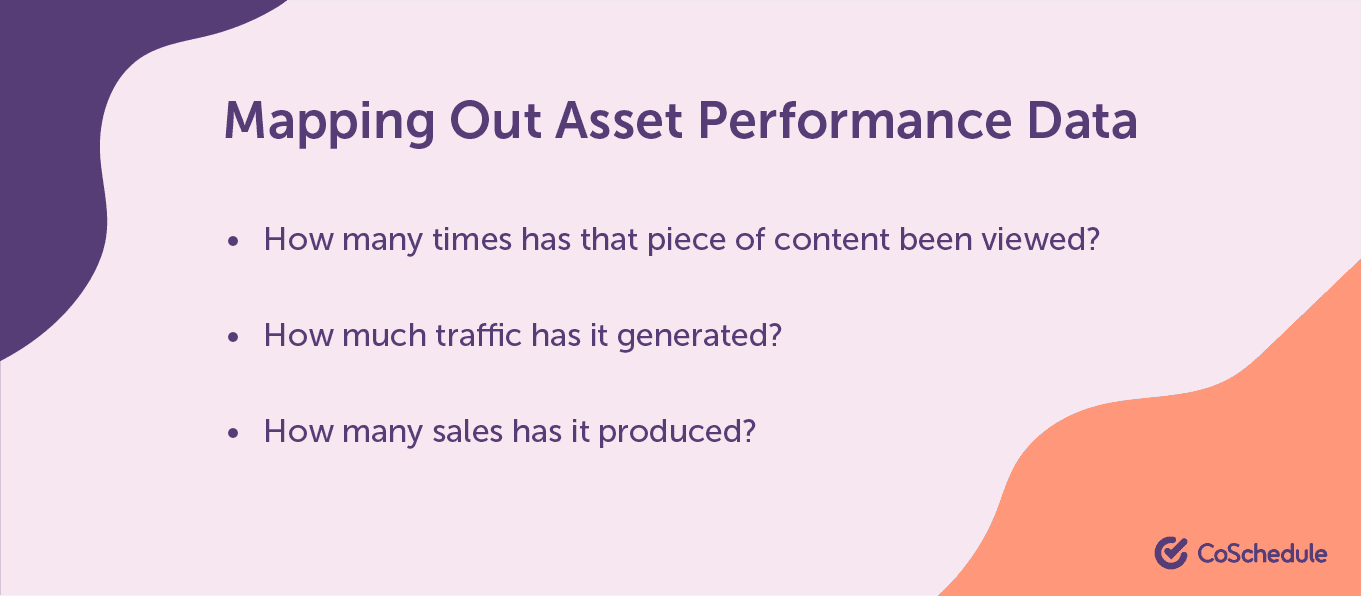 Feedback that data to your content strategists, and they’ll turn those insights into recommendations. The end result: a constantly-refreshed strategy that stays cuts things that aren’t working and focuses on those that do.
Feedback that data to your content strategists, and they’ll turn those insights into recommendations. The end result: a constantly-refreshed strategy that stays cuts things that aren’t working and focuses on those that do.
11. Educate Your Team Members
Congratulations! You’ve made a content management process that’ll make managing content a breeze, but only if your team actually follows the guidelines and workflows you’ve put in place. Make a simple document that explains how content should be:- Created
- Stored
- Tagged
- Managed


